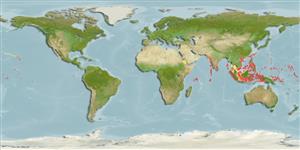Common names from other countries
>
Gobiiformes (Gobies) >
Gobiidae (Gobies) > Gobiinae
Etymology: Trimma: Greek, trimma, -atos = something crushed (Ref. 45335).
Environment: milieu / climate zone / depth range / distribution range
Ecologie
marien rifbewoner; diepte 20 - 50 m (Ref. 54980). Tropical; 28°N - 8°S
Indo-Pacific: Maldives to Hawaiian and Society Islands; Japan to Australia (Queensland and Northwest Shelf); throughout East Indian region.
Grootte / Gewicht / Leeftijd
Maturity: Lm ? range ? - ? cm
Max length : 3.5 cm SL mannelijk / geslacht onbekend; (Ref. 48637)
Korte beschrijving
Determinatiesleutels | Morfologie | Morfometrie
Dorsale stekels (totaal) : 7; Dorsale zachte stralen (totaal) : 10 - 11; Anale stekels: 1; Anale zachte stralen: 9 - 10. Males have longer dorsal spines and yellow spotting on the fins (Ref. 1602); characterized further by semi-translucent upper part of body, pinkish orange below; head and median fins with yellow orange spots; elongate and filamentous second dorsal spine; fifth pelvic ray branched, 75-85% length of fourth ray; longitudinal scale series 23-24; predorsal scales absent; cheek and opercle without scales; depth of body 4.0-4.2 in SL (Ref. 90102).
Benthopelagic (Ref. 58302). Occur in caves of drop-offs at depths of about 25 to at least 50 m (Ref. 48637, 58302). Form loose schools near the roofs or sides of caves and disappears into holes or crevices when approached. Often seen with other species of Trimma and feeds on harpacticoid copepods (Ref. 48637).
Levenscyclus en paargedrag
Maturities | Voortplanting | Spawnings | Egg(s) | Fecundities | Larven
Myers, R.F., 1991. Micronesian reef fishes. Second Ed. Coral Graphics, Barrigada, Guam. 298 p. (Ref. 1602)
Status op de Rode Lijst van het IUCN (Ref. 130435)
CITES (Ref. 128078)
Not Evaluated
Gevaar voor de mens
Harmless
Gebruik door de mens
Tools
Speciale rapporten
Download XML
Internetbronnen
Estimates based on models
Preferred temperature (Ref.
115969): 24.6 - 28.5, mean 27.9 (based on 85 cells).
Fylogenetische diversiteitsindex (Ref.
82804): PD
50 = 0.5000 [Uniqueness, from 0.5 = low to 2.0 = high].
Bayesian length-weight: a=0.01023 (0.00477 - 0.02194), b=3.02 (2.84 - 3.20), in cm Total Length, based on LWR estimates for this (Sub)family-body shape (Ref.
93245).
Trofisch niveau (Ref.
69278): 3.0 ±0.00 se; based on food items.
Weerstandsvermogen (Ref.
120179): Hoog, minimale populatieverdubbelingstijd minder dan 15 maanden (Preliminary K or Fecundity.).
Fishing Vulnerability (Ref.
59153): Low vulnerability (10 of 100).
